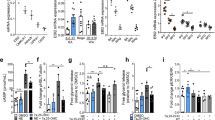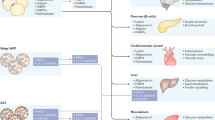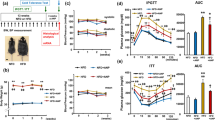Abstract
The catecholamines and the adrenergic receptors have been long known to be vital components in the regulation of fat cell metabolism. Whether in response to stress, cold temperature or diet, the β-adrenergic receptors (βARs) respond to epinephrine/norepinephrine to activate a signalling cascade that drives triglyceride hydrolysis to free fatty acids for use as fuel for skeletal and cardiac muscle work. The βARs also are well-established activators of brown fat for the conversion of substrate energy to generate heat from the oxidation of glucose and fatty acids. Long thought to be irrelevant to the biology of adult humans, the realization that there is indeed functional brown fat in humans has now created great interest and enthusiasm over the possibility that recruiting brown fat to target obesity and metabolic disease could represent a viable therapeutic option. Coupled with newer evidence that various stimuli independent of the βARs may also be able to increase active brown adipocytes, including the cardiac natriuretic peptides, it is an exciting time to be working in this area. This review will focus on the catecholamines and natriuretic peptides as cooperative actors in promoting fat metabolism, and will consider areas in need of further research.
This is a preview of subscription content, access via your institution
Access options
Subscribe to this journal
We are sorry, but there is no personal subscription option available for your country.
Buy this article
- Purchase on Springer Link
- Instant access to full article PDF
Prices may be subject to local taxes which are calculated during checkout


Similar content being viewed by others
References
Aherne W, Hull D . The site of heat production in the newborn infant. Proc R Soc Med 1964; 57: 1172–1173.
Nedergaard J, Bengtsson T, Cannon B . Unexpected evidence for active brown adipose tissue in adult humans. Am J Physiol Endocrinol Metab 2007; 293: E444–E452.
Nedergaard J, Bengtsson T, Cannon B . Three years with adult human brown adipose tissue. Ann NY Acad Sci 2010; 1212: E20–E36.
Collins S, Petro AE, Surwit RS . Strain-specific response to β3-adrenergic receptor agonist treatment of diet-induced obesity in mice. Endocrinology 1997; 138: 405–413.
Guerra C, Koza RA, Yamashita H, Walsh K, Kozak LP . Emergence of brown adipocytes in white fat in mice is under genetic control. Effects on body weight and adiposity. J Clin Invest 1998; 102: 412–420.
Almind K, Kahn CR . Genetic determinants of energy expenditure and insulin resistance in diet-induced obesity in mice. Diabetes 2004; 53: 3274–3285.
Auffret J, Viengchareun S, Carre N, Denis RG, Magnan C, Marie PY et al. Beige differentiation of adipose depots in mice lacking prolactin receptor protects against high-fat-diet-induced obesity. FASEB J 2012; 26: 3728–3737.
Ouellet V, Labbe SM, Blondin DP, Phoenix S, Guerin B, Haman F et al. Brown adipose tissue oxidative metabolism contributes to energy expenditure during acute cold exposure in humans. J Clin Invest 2012; 122: 545–552.
Saito M, Okamatsu-Ogura Y, Matsushita M, Watanabe K, Yoneshiro T, Nio-Kobayashi J et al. High incidence of metabolically active brown adipose tissue in healthy adult humans: effects of cold exposure and adiposity. Diabetes 2009; 58: 1526–1531.
van Marken Lichtenbelt WD, Vanhommerig JW, Smulders NM, Drossaerts JM, Kemerink GJ, Bouvy ND et al. Cold-activated brown adipose tissue in healthy men. N Engl J Med 2009; 360: 1500–1508.
Vijgen GH, Bouvy ND, Teule GJ, Brans B, Hoeks J, Schrauwen P et al. Increase in brown adipose tissue activity after weight loss in morbidly obese subjects. J Clin Endocrinol Metab 2012; 97: E1229–E1233.
Sarzani R, Paci VM, Dessi-Fulgheri P, Espinosa E, Rappelli A . Comparative analysis of atrial natriuretic peptide receptor expression in rat tissues. J Hypertens Suppl 1993; 11: S214–S215.
Sarzani R, Dessi-Fulgheri P, Paci VM, Espinosa E, Rappelli A . Expression of natriuretic peptide receptors in human adipose and other tissues. J Endocrinol Invest 1996; 19: 581–585.
Potter LR . Natriuretic peptide metabolism, clearance and degradation. FEBS J 2011; 278: 1808–1817.
Dessi-Fulgheri P, Sarzani R, Tamburrini P, Moraca A, Espinosa E, Cola G et al. Plasma atrial natriuretic peptide and natriuretic peptide receptor gene expression in adipose tissue of normotensive and hypertensive obese patients. J Hypertens 1997; 15 (12 Part 2): 1695–1699.
Wang TJ, Larson MG, Levy D, Benjamin EJ, Leip EP, Wilson PW et al. Impact of obesity on plasma natriuretic peptide levels. Circulation 2004; 109: 594–600.
Khan AM, Cheng S, Magnusson M, Larson MG, Newton-Cheh C, McCabe EL et al. Cardiac natriuretic peptides, obesity, and insulin resistance: evidence from two community-based studies. J Clin Endocrinol Metab 2011; 96: 3242–3249.
Sugisawa T, Kishimoto I, Kokubo Y, Makino H, Miyamoto Y, Yoshimasa Y . Association of plasma B-type natriuretic peptide levels with obesity in a general urban Japanese population: the Suita Study. Endocr J 2010; 57: 727–733.
Modan M, Halkin H, Almog S, Lusky A, Eshkol A, Shefi M et al. Hyperinsulinemia. A link between hypertension obesity and glucose intolerance. J Clin Invest 1985; 75: 809–817.
Landsberg L . Diet, obesity and hypertension: an hypothesis involving insulin, the sympathetic nervous system, and adaptive thermogenesis. Q J Med 1986; 61: 1081–1090.
Clerico A, Giannoni A, Vittorini S, Emdin M . The paradox of low BNP levels in obesity. Heart Fail Rev 2012; 17: 81–96.
Sengenes C, Berlan M, De Glisezinski I, Lafontan M, Galitzky J . Natriuretic peptides: a new lipolytic pathway in human adipocytes. FASEB J 2000; 14: 1345–1351.
Galitzky J, Sengenes C, Thalamas C, Marques MA, Senard JM, Lafontan M et al. The lipid-mobilizing effect of atrial natriuretic peptide is unrelated to sympathetic nervous system activation or obesity in young men. J Lipid Res 2001; 42: 536–544.
Bordicchia M, Liu D, Amri EZ, Ailhaud G, Dessi-Fulgheri P, Zhang C et al. Cardiac natriuretic peptides act via p38 MAPK to induce the brown fat thermogenic program in mouse and human adipocytes. J Clin Invest 2012; 122: 1022–1036.
Cao W, Medvedev AV, Daniel KW, Collins S . Adrenergic activation of p38 MAP kinase in adipocytes: cAMP induction of the uncoupling protein-1 (UCP1) gene requires p38 MAP kinase. J Biol Chem 2001; 276: 27077–27082.
Cao W, Robidoux J, Puigserver P, Daniel KW, Medvedev AV, Bai X et al. p38 MAP kinase is the central regulator of cAMP-dependent transcription of the brown fat uncoupling protein-1 gene. Mol Cell Biol 2004; 24: 3057–3067.
Reynisdottir S, Wahrenberg H, Carlström K, Rössner S, Arner P . Catecholamine resistance in fat cells of women with upper-body obesity due to decreased expression of beta2-adrenoceptors. Diabetolgia 1994; 37: 428–435.
Reynisdottir S, Ellerfeldt K, Wahrenberg H, Lithell H, Arner P . Multiple lipolysis defects in the insulin resistance (metabolic) syndrome. J Clin Invest 1994; 93: 2590–2599.
Collins S, Daniel KW, Rohlfs EM, Ramkumar V, Taylor IL, Gettys TW . Impaired expression and functional activity of the β3- and β1-adrenergic receptors in adipose tissue of congenitally obese (C57BL/6J ob/ob) mice. Mol Endocrinol 1994; 8: 518–527.
Collins S, Daniel KW, Rohlfs EM . Depressed expression of adipocyte beta-adrenergic receptors is a common feature of congenital and diet-induced obesity in rodents. Int J Obes Relat Metab Disord 1999; 23: 669–677.
Soloveva V, Graves R, Rasenick M, Spiegelman B, Ross S . Transgenic mice overexpressing the β1-adrenergic adipose tissue are resistant to obesity. Mol Endocrinol 1997; 11: 27–38.
Sarzani R, Paci VM, Zingaretti CM, Pierleoni C, Cinti S, Cola G et al. Fasting inhibits natriuretic peptides clearance receptor expression in rat adipose tissue. J Hypertens 1995; 13: 1241–1246.
Garg R, Oliver PM, Maeda N, Pandey KN . Genomic structure, organization, and promoter region analysis of murine guanylyl cyclase/atrial natriuretic peptide receptor-A gene. Gene 2002; 291: 123–133.
Sengenes C, Zakaroff-Girard A, Moulin A, Berlan M, Bouloumie A, Lafontan M et al. Natriuretic peptide-dependent lipolysis in fat cells is a primate specificity. Am J Physiol Regul Integr Comp Physiol 2002; 283: R257–R265.
Oliver PM, Fox JE, Kim R, Rockman HA, Kim HS, Reddick RL et al. Hypertension, cardiac hypertrophy, and sudden death in mice lacking natriuretic peptide receptor A. Proc Natl Acad Sci USA 1997; 94: 14730–14735.
Oliver PM, John SW, Purdy KE, Kim R, Maeda N, Goy MF et al. Natriuretic peptide receptor 1 expression influences blood pressures of mice in a dose-dependent manner. Proc Natl Acad Sci USA 1998; 95: 2547–2551.
Matsukawa N, Grzesik WJ, Takahashi N, Pandey KN, Pang S, Yamauchi M et al. The natriuretic peptide clearance receptor locally modulates the physiological effects of the natriuretic peptide system. Proc Natl Acad Sci USA 1999; 96: 7403–7408.
Engeli S, Birkenfeld AL, Badin PM, Bourlier V, Louche K, Viguerie N et al. Natriuretic peptides enhance the oxidative capacity of human skeletal muscle. J Clin Invest 2012; 122: 4675–4679.
Author information
Authors and Affiliations
Corresponding author
Ethics declarations
Competing interests
SC has received consulting fees from Merck and Astra-Zeneca and received grant support through the Novo Nordisk Diabetes Innovation Award. The remaining authors declare no conflict of interest.
Additional information
This article is published as part of a supplement sponsored by the Université Laval's Research Chair in Obesity in an effort to inform the public on the causes, consequences, treatments, and prevention of obesity.
Rights and permissions
About this article
Cite this article
Collins, S., Sarzani, R. & Bordicchia, M. Coordinate control of adipose ‘browning’ and energy expenditure by β-adrenergic and natriuretic peptide signalling. Int J Obes Supp 4 (Suppl 1), S17–S20 (2014). https://doi.org/10.1038/ijosup.2014.6
Published:
Issue Date:
DOI: https://doi.org/10.1038/ijosup.2014.6
Keywords
This article is cited by
-
Fibroblast growth factor 8b induces uncoupling protein 1 expression in epididymal white preadipocytes
Scientific Reports (2019)



